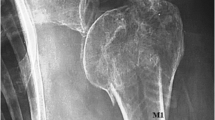Abstract
Purpose
Pathologic changes of the glenohumeral joint, like a long-standing overloading or an accident often lead to severe glenohumeral osteoarthritis, and a glenohumeral joint replacement could be necessary. Joint instability and glenoid loosening are the most common post-operative complications, which can be caused by eccentric loading of the glenoid, if the humeral head is malcentered. If these malcentered cases could be identified pre-operatively, the pathologic position of the humeral head could be fixed intra-operatively and complication may be prevented. Computed tomography osteoabsorptiometry (CT-OAM) is a useful method to determine the distribution of mineralisation in the subchondral bone as a marker for the long-term loading history of a joint. The objective of this study was to gain information about the mineralisation distribution in the subchondral bone plate of the humeral head.
Methods
By the use of CT-OAM, the distribution of the subchondral mineralisation of 69 humeral heads was investigated and groups of mineralisation patterns were built. To evaluate if differences in age exist, the mean values of the two groups were compared using t test.
Results
49 humeral heads (71% of 69 specimens) showed bicentric subchondral mineralisation patterns with ventral and dorsal maxima, 20 humeral heads (29% of 69 specimens) could be classified as monocentric with a centro-dorsal maximum. We found no statistical significant difference between the age of the monocentric and the bicentric group on a significance level of 95%.
Conclusion
We could show that stress distribution at the humeral head is typically bicentric with a ventral and dorsal maximum. However, other mineralisation patterns may occur under pathologic circumstances. The pre-operative identification of such cases by the use of CT-OAM could help to improve the post-operative results in shoulder surgery.



Similar content being viewed by others
References
Bullough PG (1981) The geometry of diarthrodial joints, its physiologic maintenance, and the possible significance of age-related changes in geometry-to-load distribution and the development of osteoarthritis. Clin Orthop Relat Res 156:61–66. doi:10.1097/00003086-198105000-00008
Carter DR, Fyhrie DP, Whalen RT (1987) Trabecular bone density and loading history: regulation of connective tissue biology by mechanical energy. J Biomech 20(8):785–794
Eckstein F, Merz B, Schon M, Jacobs CR, Putz R (1999) Tension and bending, but not compression alone determine the functional adaptation of subchondral bone in incongruous joints. Anat Embryol (Berl) 199(1):85–97
Frost HM (1990) Skeletal structural adaptations to mechanical usage (SATMU): 2. redefining Wolff’s law: the remodeling problem. Anat Rec 226(4):414–422. doi:10.1002/ar.1092260403
Mimar R, Limb D, Hall RM (2008) Evaluation of the mechanical and architectural properties of glenoid bone. J Should Elb Surg 17(2):336–341. doi:S1058-2746(07)00657-X
Muhlhofer H, Ercan Y, Drews S, Matsuura M, Meissner J, Linsenmaier U, Putz R, Muller-Gerbl M (2009) Mineralisation and mechanical strength of the subchondral bone plate of the inferior tibial facies. Surg Radiol Anat 31(4):237–243. doi:10.1007/s00276-008-0430-6
Muller-Gerbl M, Putz R, Hodapp N, Schulte E, Wimmer B (1989) Computed tomography-osteoabsorptiometry for assessing the density distribution of subchondral bone as a measure of long-term mechanical adaptation in individual joints. Skelet Radiol 18(7):507–512. doi:10.1007/BF00351749
Muller-Gerbl M, Putz R, Hodapp N, Schulte E, Wimmer B (1990) Demonstration of subchondral density pattern using CT-osteoabsorptiometry (CT-OAM) for the assessment of individual joint stress in live patients. Z Orthop Ihre Grenzgeb 128(2):128–133. doi:10.1055/s-2008-1039487
Muller-Gerbl M, Putz R, Kenn R (1993) Distribution pattern of subchondral mineralization in the glenoid cavity in normal subjects, athletes and patients. Z Orthop Ihre Grenzgeb 131(1):10–13. doi:10.1055/s-2008-1039896
Muller-Gerbl M (1998) The subchondral bone plate. Adv Anat Embryol Cell Biol 141(III–XI):1–134
Oberlander W (1973) [The stress of the human hip joint. V: the distribution of bone density in the human acetabulum (author’s transl)]. Z Anat Entwicklungsgesch 140(3):367–384. doi:10.1007/BF00525062
Schulz CU, Pfahler M, Anetzberger HM, Becker CR, Muller-Gerbl M, Refior HJ (2002) The mineralization patterns at the subchondral bone plate of the glenoid cavity in healthy shoulders. J Should Elb Surg 11(2):174–181. doi:10.1067/mse.2002.121635
Schulz CU, Anetzberger H, Pfahler M, Refior HJ, Muller-Gerbl M (2004) Anterior shoulder instability modifies glenoid subchondral bone density. Clin Orthop Relat Res 423:259–263. doi:00003086-200406000-00042
Soslowsky LJ, Flatow EL, Bigliani LU, Mow VC (1992) Articular geometry of the glenohumeral joint. Clin Orthop Relat Res 285:181–190
Tillmann B (1971) [The stress of the human elbow joint. I: functional morphology of the articular surfaces]. Z Anat Entwicklungsgesch 134(3):328–342. doi:10.1007/BF00519919
von Eisenhart-Rothe R, Muller-Gerbl M, Wiedemann E, Englmeier KH, Graichen H (2008) Functional malcentering of the humeral head and asymmetric long-term stress on the glenoid: potential reasons for glenoid loosening in total shoulder arthroplasty. J Should Elb Surg 17(5):695–702. doi:10.1016/j.jse.2008.02.008
Conflict of interest
The authors declare that they have no conflict of interest.
Author information
Authors and Affiliations
Corresponding author
Rights and permissions
About this article
Cite this article
Zumstein, V., Kraljević, M., Huegli, R. et al. Mineralisation patterns in the subchondral bone plate of the humeral head. Surg Radiol Anat 33, 775–779 (2011). https://doi.org/10.1007/s00276-011-0819-5
Received:
Accepted:
Published:
Issue Date:
DOI: https://doi.org/10.1007/s00276-011-0819-5




